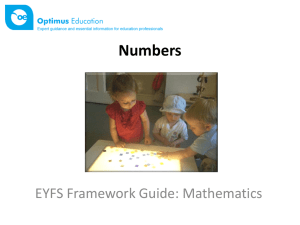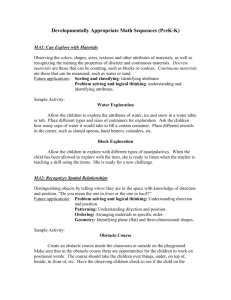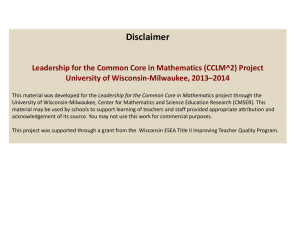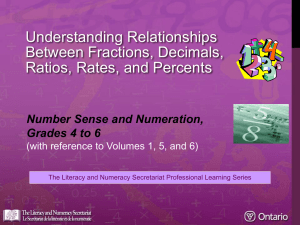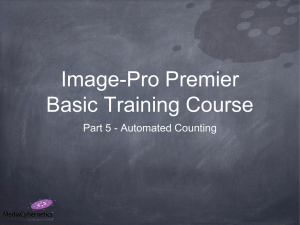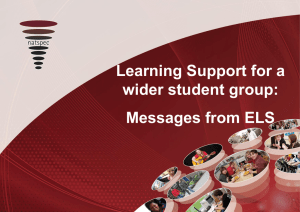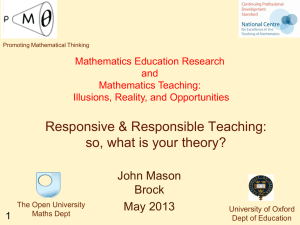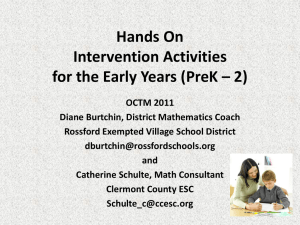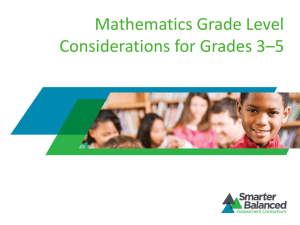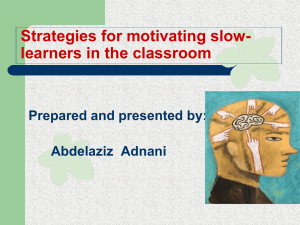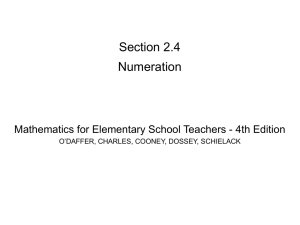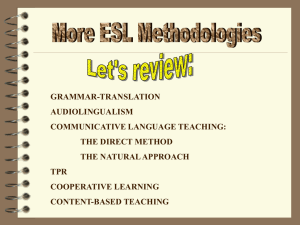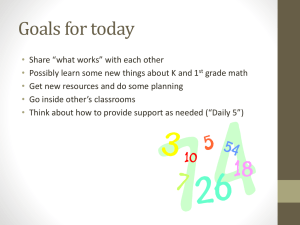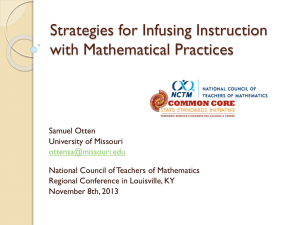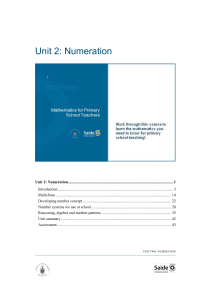Initial Mathematics Assessment Gr. 1 - 8
advertisement
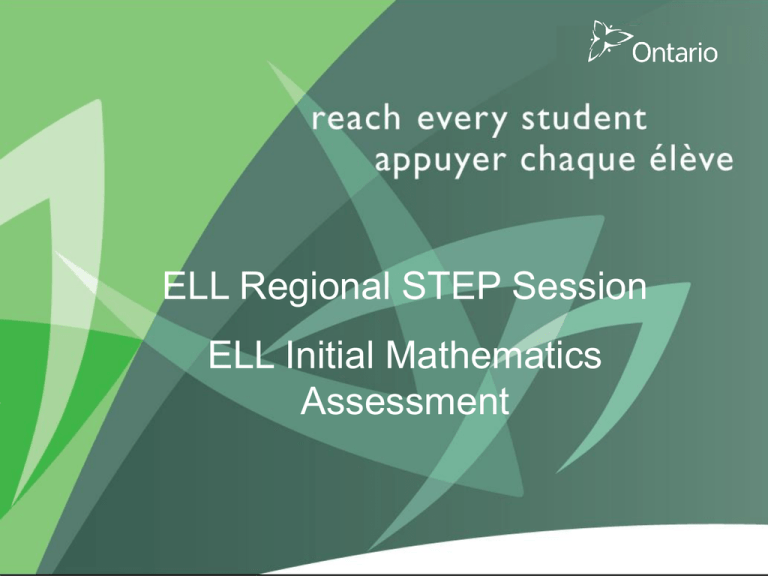
ELL Regional STEP Session ELL Initial Mathematics Assessment 1 Every day, more than one million English language learners attend Ontario’s publicly funded schools. They come from every country and every circumstance. They bring with them a valuable world perspective needed by all students to operate successfully in a global community. Supporting English Language Learners: A practical guide for Ontario educators, Grades 1 to 8, 2008, p. 17 Agenda Focused Conversations about the ELL Math Assessment Tool including: • Background information and overview • Materials and organization • Guidelines for implementation • Mathematical knowledge/concepts 2 Our Shared Goals It is important that newly arrived English language learners receive a warm welcome during their transition into our Ontario schools. The initial assessment process has a strong impact on the first impressions of these students and their families. During this process, it is critical that educational staff take the opportunity to learn about the whole child and celebrate the diversity each student will bring to our classrooms. Using the Initial Mathematics Assessment Tool for English Language Learners, Grades K – 8 This tool is not intended to be a replacement for the ongoing assessment gathered by the classroom teacher. It is through a variety of assessment strategies and tools that the programming needs of all students are best addressed. Guidelines for Initial Assessment Development Begin with counting and simple computation. Give students access to manipulatives and geometric shapes. Encourage students to skip over items that seem unfamiliar and look for others that they understand. Assess a student’s knowledge of key concepts and skills in all five strands of the Ontario mathematics curriculum appropriate for the grade level (e.g., if an English language learner is placed ageappropriately in Grade 5 in September, then assess knowledge of the Grade 4 mathematics curriculum. If the student arrives in January, assess some of the mathematical concepts already covered in Grade 5 as well.) Accept different ways to show calculations, as long as they yield correct answers. Supporting English Language Learners: A practical guide for Ontario educators, Grades 1 to 8, 2008, p. 34-35 Materials Assessment Flow Chart Grade level packages which include: 1. One assessment tool for each mathematical strand 2. Teacher Instruction and Observation Page by strand (including materials) and Student Booklet (for Number Sense and Numeration grades 1-8 only) 3. List of process expectations relating to the Number Sense and Numeration problem solving question included in the grade 1 to grade 8 assessments 4. List of expectations addressed in each strand assessment tool Begin with the Flowchart Initial Mathematics Assessment Tool for English Language Learners, Grades K – 8 • • • 1. 2. 3. 4. 5. 6. 7. 8. Aligned with Ontario Mathematics curriculum expectations Grade specific assessment tools are based on previous grade curriculum expectations Student assessments do not show specific grade level but are coded by letter: A (kindergarten/grade one assessment based on kindergarten expectations) B (grade two assessment based on grade one expectations) C (grade three assessment based on grade two expectations) D (grade four assessment based on grade three expectations) E (grade five assessment based on grade four expectations) F (grade six assessment based on grade five expectations) G (grade seven assessment based on grade six expectations) H (grade eight assessment based on grade seven expectations) Using the Initial Mathematics Assessment Tool for English Language Learners, Grades K – 8 For each grade level strand assessment, a cluster of expectations has been selected to provide a starting point in determining the mathematical knowledge and skills of the student. It would not be reasonable or appropriate to assess all curriculum expectations within this initial assessment. Taking a Closer Look at the Features of the Number Sense and Numeration Assessments Teacher/Assessor Copy Student Copy Important Considerations ELLs arrive in our Ontario schools with varying background experiences and English language acquisition skills. The teacher/assessor should always consider the individual student needs, and use professional judgement in the use of this assessment tool. At any point, if the student is experiencing difficulty, the assessor should allow the student to move ahead to the next question or stop altogether. There are many factors which may impact the performance of a student (e.g., acculturation process, performance anxiety, and subject specific language). Number Sense and Numeration Key mathematical number sense and numeration concepts in the primary assessments include: • Quantity Relationships (composing and decomposing numbers - anchors of five and ten, subitizing, comparing and representing quantities) • Counting (stable order, one-to-one correspondence, cardinality, conservation of number, movement is magnitude) • Operational sense (addition and subtraction of single and double digit numbers, multiplication) Composing and Decomposing Numbers Anchors of Five and Ten What is 8 + 7 ? What is 9 + 6 ? What is 7 + 6 ? What is 8 + 3 ? Subitizing Identifying a quantity without needing to count Subitizing • What quantity did you see in the first dot configuration? What strategy did you use to determine the quantity? • What quantity did you see in the second dot configuration? What strategy did you use to determine the quantity? Counting Principles Some of the key counting principles include: • stable order • one-to-one correspondence • Cardinality • conservation of number • movement is magnitude Principles of Counting Stable Order Principle 1,2,3,4,5,6… not 1,2,3,4,6,8,9,10 Principles of Counting Order Irrelevance Principle 6 in this group 1 6 in this group 2 3 4 5 6 OR 6 1 5 2 4 3 Principles of Counting Conservation Principle Principles of Counting One-to-One Correspondence Principles of Counting Cardinality Principle 1 3 2 5 4 7 6 8 Principles of Counting Movement is Magnitude Principle 1 2 3 4 5 Operational Sense What strategies could you use to find the sum? What strategies could you use to find the difference? 83 + 8 55 - 13 Number Sense and Numeration Key mathematical number sense and numeration concepts in the junior and intermediate assessments include: Quantity Relationships 1. read, represent, compare and order whole numbers, fractions, decimals Operational Sense 1. single and multi-digit computation involving the four operations – increasingly focusing on multiplicative thinking 2. Order of Operations (introduced in the grade eight (H) assessment 3. operations with fractions, decimals, integers (in intermediate assessments) Proportional Reasoning 1. Relationships between fractions, decimals and percents Quantity Relationships • Form partners and/or trios • Each group will need a copy of the grade seven (G) booklet and the accompanying teacher/assessor instruction booklet Read and discuss the following questions: 1, 2, 3, 5, 6, 7,10, 12, and 13 Operational Sense • Continue to work in partners and/or trios Task One Read and discuss the following questions: 4, 8, and 11 Task Two Select one of the expressions in question 4. As a table group, use chart paper to show how many different ways you could find the answer. What manipulatives could help you? What manipulatives could help the students? Be prepared to share with our whole group. Proportional Reasoning Read and discuss the following question: 9 What are some observations/assessment information you anticipate could be gathered from this question? Using the Initial Mathematics Assessment Tool for English Language Learners, Grades K – 8 This tool is not intended to be a replacement for the ongoing assessment gathered by the classroom teacher. It is through a variety of assessment strategies and tools that the programming needs of all students are best addressed. Our agenda…in review Focused Conversations about the ELL Math Assessment Tool including: • Background information and overview • Materials and organization • Guidelines for implementation • Mathematical knowledge/concepts Questions?? 2
